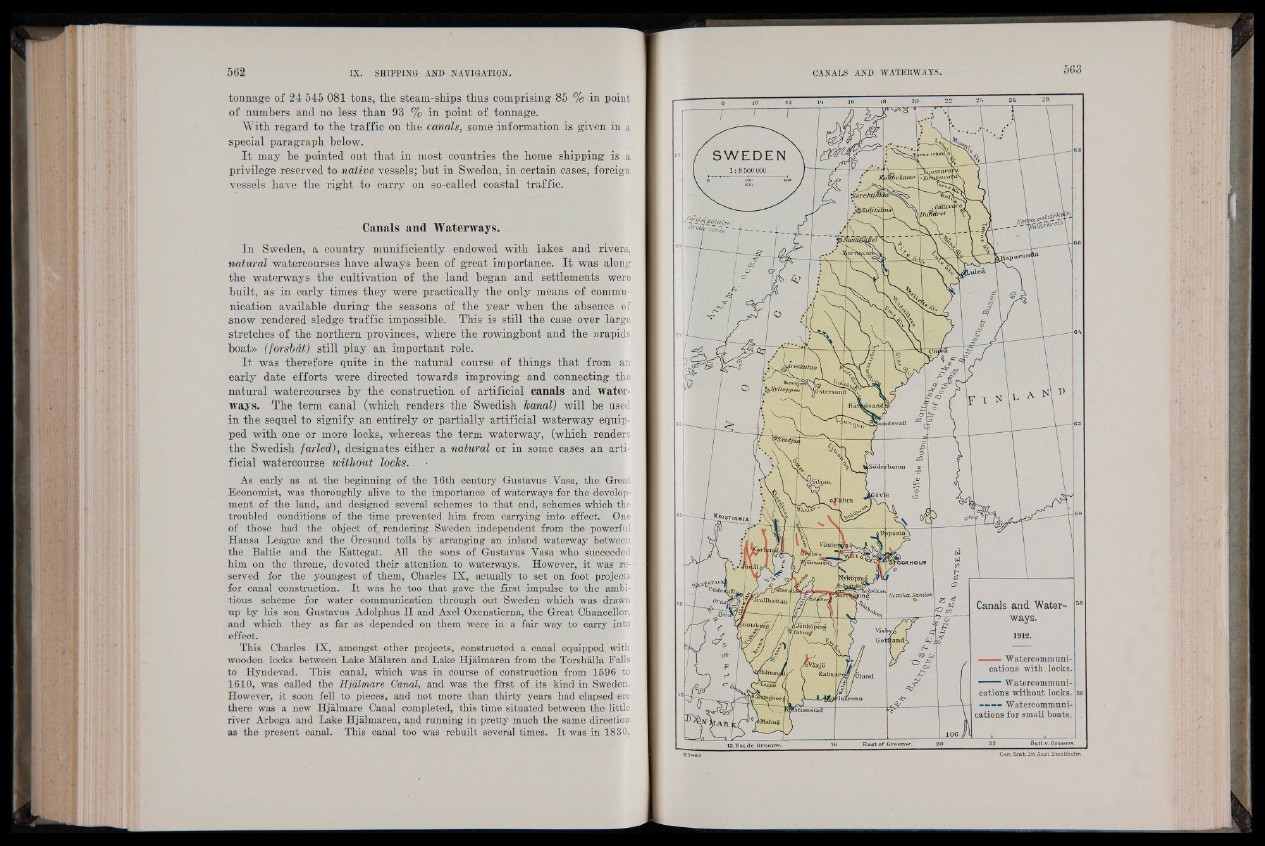
tonnage of 24 545 081 tons, the steam-ships thus comprising 85 % in point
of numbers and no less than 98 % in point of tonnage.
With regard to the traffic on the canals, some information is given in a
special paragraph below.
It may be pointed out that in most countries the home shipping is a
privilege reserved to native vessels; but in Sweden, in certain cases, foreign
vessels have the right to carry on so-called coastal traffic.
Canals and Waterways.
In Sweden, a country munificiently endowed with lakes and rivers,
natural watercourses have always been of great importance. It was along
the waterways the cultivation of the land began and settlements were
built, as in early times they were practically the only means of communication
available during the seasons of the year when the absence of
snow rendered sledge traffic impossible. This is still the case over large
stretches of the northern provinces, where the rowingboat and the »rapids
boat» (forsbät) still play an important role.
It was therefore quite in the natural course of things that from • an
early date efforts were directed towards improving and connecting the
natural watercourses by the construction of artificial canals and waterways.
The term canal (which renders the Swedish hanal) will be used
in the sequel to signify an entirely or partially artificial waterway equipped
with one or more locks, whereas the term waterway, (which renders
the Swedish farled), designates either a natural or in some cases an artificial
watercourse without locks.
As early as at the beginning of the 16th century Gustavus Vasa, the Great
Economist, was thoroughly alive to the importance of waterways for the development
of the land, and designed several schemes to that end, schemes which the
troubled conditions of the time prevented him from carrying into effect.. One
of those had the object of. rendering Sweden independent from the powerful
Hansa League and the Öresund tolls by arranging an inland waterway between
the Baltic and the Kattegat. All the sons of Gustavus Vasa who succeeded
him on the throne, devoted their attention to waterways. However, it was reserved
for the youngest of them, Charles IX, actually to set on foot projects
for canal construction. It was he too th a t gave the first impulse to the ambitious
scheme for water communication through out Sweden which was drawn
up by his son Gustavus Adolphus n and Axel Oxenstierna, the Great Chancellor,
and which they as far as depended on them were in a fair way to carry into
effect.
This Charles IX, amongst other projects, constructed a canal equipped with
wooden locks between Lake Mälaren and Lake Hjälmaren from the Torshälla Falls
to Hyndevad. This canal, which was in course of construction from 1596 to
1610, was called the Hjälmare Canal, and was the first of its kind in Sweden.
However, it soon fell to pieces, and not more than thirty years had elapsed ere
there was a new Hjälmare Canal completed, this time situated between the little
river Arboga and Lake Hjälmaren, and running in pretty much the same direction
as the present canal. This canal too was rebuilt several times. I t was in 1830,
$ ai-ektfMcko
foSv^tSLrti .GSUivt hOar*l
Æap araw
'esitutan
(Ö ste rsu n I
H äm p s a n d
»undsväD
,S ö d e TiaTrm
S t o c k h o lm
iy k ö pm j
'TroHhäitf Canals and Waterways.
iGÖtebrfrß/ /-J odönköpinö ' J / y ß m i m
i Watercommuni-
cations with.locks.
Water communications
without locks.
—— Watercommuni-
cations for small boats.
Kabn (01 a n d
> Malmö